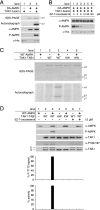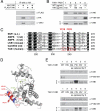Autoactivation of transforming growth factor beta-activated kinase 1 is a sequential bimolecular process
- PMID: 20538596
- PMCID: PMC2919138
- DOI: 10.1074/jbc.M109.093468
Autoactivation of transforming growth factor beta-activated kinase 1 is a sequential bimolecular process
Abstract
Transforming growth factor-beta-activated kinase 1 (TAK1), an MAP3K, is a key player in processing a multitude of inflammatory stimuli. TAK1 autoactivation involves the interplay with TAK1-binding proteins (TAB), e.g. TAB1 and TAB2, and phosphorylation of several activation segment residues. However, the TAK1 autoactivation is not yet fully understood on the molecular level due to the static nature of available x-ray structural data and the complexity of cellular systems applied for investigation. Here, we established a bacterial expression system to generate recombinant mammalian TAK1 complexes. Co-expression of TAK1 and TAB1, but not TAB2, resulted in a functional and active TAK1-TAB1 complex capable of directly activating full-length heterotrimeric mammalian AMP-activated protein kinase (AMPK) in vitro. TAK1-dependent AMPK activation was mediated via hydrophobic residues of the AMPK kinase domain alphaG-helix as observed in vitro and in transfected cell culture. Co-immunoprecipitation of differently epitope-tagged TAK1 from transfected cells and mutation of hydrophobic alphaG-helix residues in TAK1 point to an intermolecular mechanism of TAB1-induced TAK1 autoactivation, as TAK1 autophosphorylation of the activation segment was impaired in these mutants. TAB1 phosphorylation was enhanced in a subset of these mutants, indicating a critical role of alphaG-helix residues in this process. Analyses of phosphorylation site mutants of the activation segment indicate that autophosphorylation of Ser-192 precedes TAB1 phosphorylation and is followed by sequential phosphorylation of Thr-178, Thr-187, and finally Thr-184. Finally, we present a model for the chronological order of events governing TAB1-induced TAK1 autoactivation.
Figures








Similar articles
-
Critical roles of threonine 187 phosphorylation in cellular stress-induced rapid and transient activation of transforming growth factor-beta-activated kinase 1 (TAK1) in a signaling complex containing TAK1-binding protein TAB1 and TAB2.J Biol Chem. 2005 Feb 25;280(8):7359-68. doi: 10.1074/jbc.M407537200. Epub 2004 Dec 7. J Biol Chem. 2005. PMID: 15590691
-
The Yersinia enterocolitica effector YopP inhibits host cell signalling by inactivating the protein kinase TAK1 in the IL-1 signalling pathway.EMBO Rep. 2006 Aug;7(8):838-44. doi: 10.1038/sj.embor.7400754. Epub 2006 Jul 14. EMBO Rep. 2006. PMID: 16845370 Free PMC article.
-
Roles for TAB1 in regulating the IL-1-dependent phosphorylation of the TAB3 regulatory subunit and activity of the TAK1 complex.Biochem J. 2008 Feb 1;409(3):711-22. doi: 10.1042/BJ20071149. Biochem J. 2008. PMID: 18021073
-
Post-Translational Modifications of the TAK1-TAB Complex.Int J Mol Sci. 2017 Jan 19;18(1):205. doi: 10.3390/ijms18010205. Int J Mol Sci. 2017. PMID: 28106845 Free PMC article. Review.
-
Regulation of TAK-TAB Complex Activation through Ubiquitylation.Front Biosci (Landmark Ed). 2024 Apr 29;29(5):169. doi: 10.31083/j.fbl2905169. Front Biosci (Landmark Ed). 2024. PMID: 38812304 Review.
Cited by
-
Deciphering the Role of Innate Immune NF-ĸB Pathway in Pancreatic Cancer.Cancers (Basel). 2020 Sep 19;12(9):2675. doi: 10.3390/cancers12092675. Cancers (Basel). 2020. PMID: 32961746 Free PMC article. Review.
-
IKK promotes cytokine-induced and cancer-associated AMPK activity and attenuates phenformin-induced cell death in LKB1-deficient cells.Sci Signal. 2018 Jul 10;11(538):eaan5850. doi: 10.1126/scisignal.aan5850. Sci Signal. 2018. PMID: 29991651 Free PMC article.
-
HDAC6-dependent deacetylation of TAK1 enhances sIL-6R release to promote macrophage M2 polarization in colon cancer.Cell Death Dis. 2022 Oct 21;13(10):888. doi: 10.1038/s41419-022-05335-1. Cell Death Dis. 2022. PMID: 36270986 Free PMC article.
-
TAK1 (MAP3K7) signaling regulates hematopoietic stem cells through TNF-dependent and -independent mechanisms.PLoS One. 2012;7(11):e51073. doi: 10.1371/journal.pone.0051073. Epub 2012 Nov 30. PLoS One. 2012. PMID: 23226465 Free PMC article.
-
Activated macrophage survival is coordinated by TAK1 binding proteins.PLoS One. 2014 Apr 15;9(4):e94982. doi: 10.1371/journal.pone.0094982. eCollection 2014. PLoS One. 2014. PMID: 24736749 Free PMC article.
References
-
- Yamaguchi K., Shirakabe K., Shibuya H., Irie K., Oishi I., Ueno N., Taniguchi T., Nishida E., Matsumoto K. (1995) Science 270, 2008–2011 - PubMed
-
- Ninomiya-Tsuji J., Kishimoto K., Hiyama A., Inoue J., Cao Z., Matsumoto K. (1999) Nature 398, 252–256 - PubMed
-
- Wang C., Deng L., Hong M., Akkaraju G. R., Inoue J., Chen Z. J. (2001) Nature 412, 346–351 - PubMed
-
- Takaesu G., Surabhi R. M., Park K. J., Ninomiya-Tsuji J., Matsumoto K., Gaynor R. B. (2003) J. Mol. Biol. 326, 105–115 - PubMed
-
- Lee J., Mira-Arbibe L., Ulevitch R. J. (2000) J. Leukocyte Biol. 68, 909–915 - PubMed
Publication types
MeSH terms
Substances
LinkOut - more resources
Full Text Sources
Other Literature Sources
Molecular Biology Databases
Miscellaneous

